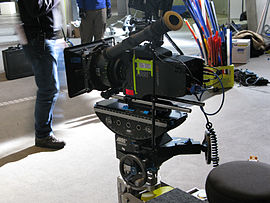Digital movie cameras for digital cinematography are digital video cameras that capture digitally rather than the historically used movie camera, which shoots on film stock. Different digital movie cameras output a variety of different acquisition formats. Cameras designed for domestic use have also been used for some low-budget independent productions. Since the beginning of the 2010s, digital movie cameras have become the dominant type of camera in the motion picture industry.
Beginning in the late 1980s, Sony began marketing the concept of electronic cinematography, utilizing its analog Sony HDVS professional video cameras. The effort met with very little success. However, this led to one of the earliest electronically shot feature movies, Julia and Julia, to be produced in 1987.[1] In 1998, with the introduction of HDCAM recorders and 1920 × 1080 pixel digital professional video cameras based on CCD technology, the idea, now re-branded as digital cinematography, began to gain traction in the market.[citation needed]
In May 2001 Once Upon a Time in Mexico became the first well known movie to be shot in 24 frame-per-second high-definition digital video, partially developed by George Lucas using a Sony HDW-F900 camera,[2] following Robert Rodriguez’s introduction to the camera at George Lucas’s ranch whilst editing the sound for Spy Kids. In May 2002 Star Wars: Episode II – Attack of the Clones was released having also been shot using a Sony HDW-F900 camera. Two lesser-known movies, Vidocq (2001) and Russian Ark (2002), had also previously been shot with the same camera, the latter notably consisting of a single long take (no cuts).
In parallel with these changes, digital cinema began to emerge in the cinema system.
At the high-end of the camera market, there has been an emergence of cameras aimed specifically at the digital cinema market. These cameras from Arri, Sony, Vision Research, Silicon Imaging, Panavision, Grass Valley , Canon and Red offer resolution and dynamic range that exceeds that of digital professional video cameras, which are designed for the limited needs of broadcast television.
In 2009, Slumdog Millionaire became the first movie shot mainly in digital to be awarded the Academy Award for Best Cinematography[3] and the highest grossing movie in the history of cinema, Avatar, not only was shot on digital cameras as well, but also made the main revenues at the box office no longer by film, but digital projection.
Since the beginning of the 2010’s, the motion picture industry has almost completely switched to digital capture as well as digital distribution and projection.


Leave a Reply